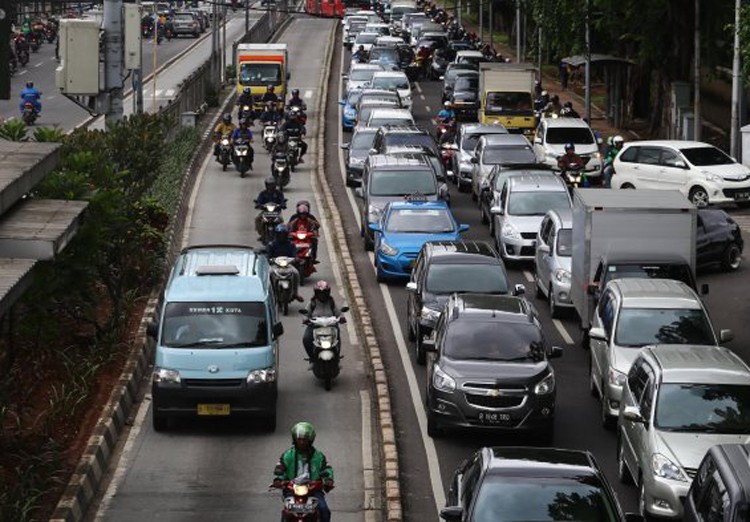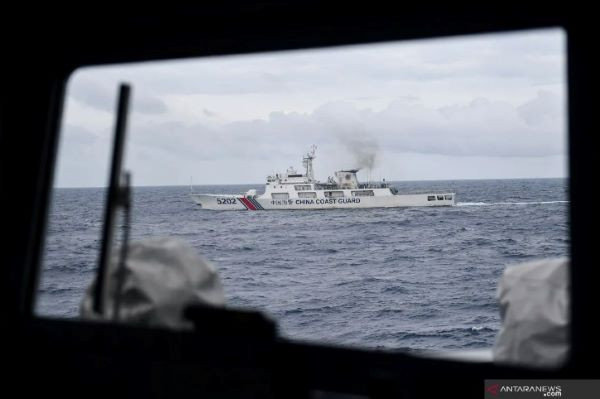Keeping bus lanes clear when police are not watching
The results of a study by German international cooperation agency GIZ state that each 3.5-meter-wide road lane could be used by 25,000 people per hour if facilitated by bus rapid transit — much higher than the average 2,000 to 4,000 people per hour when the lanes are for general traffic. With more people using public transportation, everyone would benefit and we would have lower emissions, as urban transport is a major contributor to pollution.
Change Size
 A number of vehicles intrude along a Transjakarta lane on Jl. Gunung Saharai, Central Jakarta on Monday to avoid traffic congestion along other road lanes. ( Warta Kota via tribunnews.com/Angga Bhagya Nugraha)
A number of vehicles intrude along a Transjakarta lane on Jl. Gunung Saharai, Central Jakarta on Monday to avoid traffic congestion along other road lanes. ( Warta Kota via tribunnews.com/Angga Bhagya Nugraha)
A
fter increasing the number of buses in the Transjakarta fleet, Jakarta Governor Basuki “Ahok” Tjahaja Purnama has asked the police to supervise bus lanes to keep them free of other vehicles. With the exceptions of ambulances, fire trucks and the President and Vice President, the firmness of the governor and the police should be appreciated as a step forward in the city’s commitment to a better road-based mass transit system.
With adequate infrastructure and funding as well as strong political commitments from the municipality and the police, people can hope for better Transjakarta rapid transit services. Indeed, on the first day of the initiative on June 13, the enforcement of keeping the lanes clear was widely praised by netizens who have become loyal users of Transjakarta as travel times reduced. But too often, promises evaporate along with the arrival of other, more popular issues.
One of our weaknesses is in obeying the rules when no one is watching. However, with the higher volume of traffic and the heat and rain, it would be inhumane and ineffective to assign the task of keeping bus lanes empty to only the police.
The government should improve the traffic control system with information technology devices commonly used in developed countries. Policymakers need to immediately respond to this challenge; the 2008 Law on information and electronic transactions and the 2009 Law on traffic and road transportation are already sufficient to allow electronic traffic law enforcement.
Electronic traffic law enforcement combines surveillance cameras in sections of roads and intersections and issues electronic tickets indiscriminately. It would lead to a sense of being watched around the clock and reduce the temptation to break the rules. Eventually we would see an orderly culture along with safer and better public transportation.
For mass transportation systems to develop well, political support is crucial. The government needs to regulate and guide sustainable mass transit by issuing a national urban transportation policy.
In addition, officials should not use facilities without wise discretion. In 2005, then vice president Hamzah Haz was caught red-faced when his driver used a Transjakarta lane to escape congestion, although the lane was for the absolutely exclusive use of buses.
The government needs to prioritize cultivating public interest including in the bus priority concept because of limited land in urban areas, while the population continues to grow. Bus rapid transit is need in all major cities.
The results of a study by German international cooperation agency GIZ state that each 3.5-meter-wide road lane could be used by 25,000 people per hour if facilitated by bus rapid transit — much higher than the average 2,000 to 4,000 people per hour when the lanes are for general traffic. With more people using public transportation, everyone would benefit and we would have lower emissions, as urban transport is a major contributor to pollution.
Symptoms of traffic congestion are getting worse from year to year. The Japan International Cooperation Agency predicted that Jakarta’s average traffic speed declined 0.67 km per hour annually in recent years, similar to other Indonesia cities.
Providing a segregated lane protected from general traffic is much cheaper than building a light railway in each city. A 2007 World Bank report showed that constructing a light railway required twice the average investment of a bus rapid transit system, which can also carry more passengers than light rail.
With an effective mass transit system, public interest in using public transportation should increase. Finally, the ideals of President Joko “Jokowi” Widodo to reduce congestion in urban areas as stated in his National Development Plan (RPJMN), by increasing public transportation use from only 23 percent in 2014 to 32 percent by 2019, could be achieved.
***
The writer is head of multimodal transportation at the Indonesia Transportation Society (MTI) and a member of the Jakarta Transportation Council (DTKJ). The views expressed are his own.
---------------
We are looking for information, opinions, and in-depth analysis from experts or scholars in a variety of fields. We choose articles based on facts or opinions about general news, as well as quality analysis and commentary about Indonesia or international events. Send your piece to community@jakpost.com.








